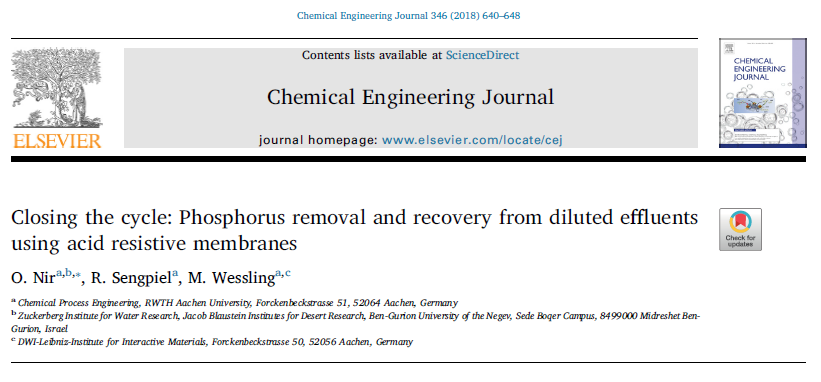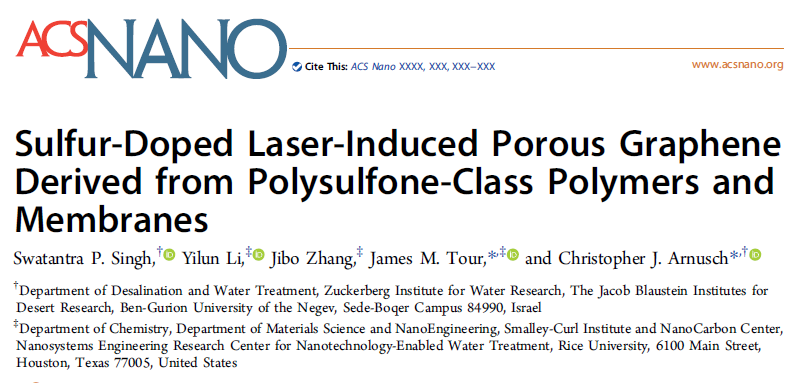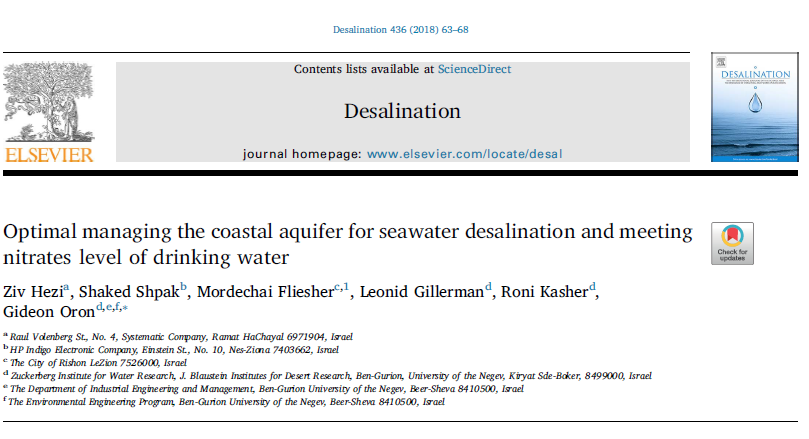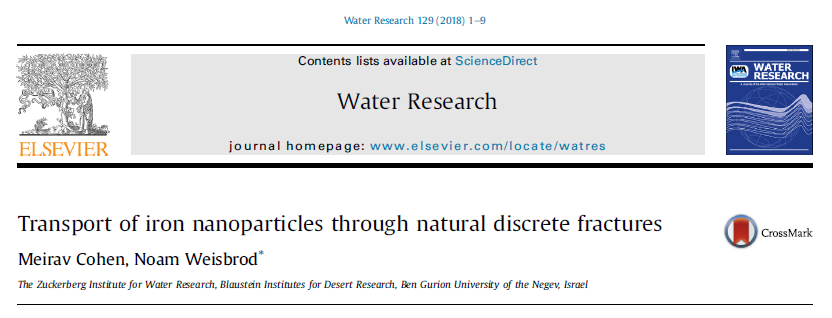A number of publications appeared recently, authored by ZIWR faculty.
Here below the abstracts and the publication details.

Biofilm formation on surfaces in technology and the environment is a problem that can lead to high costs and can endanger human lives. Namely, infrastructure, medical implants, and food processing units, as well as oil refineries, ship hulls, and membrane technology for water treatment, are affected and underline the importance of identifying low fouling surfaces. Recently, surfaces coated with laser-induced graphene (LIG) were shown to strongly resist biofilm formation. Here we investigated the role of LIG texture and surface chemistry on biofilm formation and showed that the rough LIG surface texture correlated to enhanced biofilm inhibition. Fabrication conditions of LIG led to rough surfaces containing carbon nanofibers (250−750 nm diameter), and micropores (1−25 μm), which were shown to inhibit the attachment and proliferation of bacterial cells. In contrast, LIG surfaces with crushed nanofibers and covered micropores resisted biofilm formation less effectively. By oxidizing the LIG surface using oxygen plasma, we rendered the LIG more hydrophilic (contact angle was zero), but this chemical modification had negligible effects on the biofilm formation. After biofilm growth experiments, SEM images revealed that the morphology of Psudomonas aeruginosa cells adhered to poly(ether sulfone) substrate surfaces were rod-like in contrast to more spherical shaped cells on the LIG surfaces, which suggested distress. This study gives evidence of the importance of surface texture in antifouling applications and desirable design features such as nanofibers for effective antifouling LIG surfaces in energy, environmental, and biomedical fields.
ACS Appl. Nano Mater., 2018, 1 (4), pp 1713–1720
DOI: 10.1021/acsanm.8b00175
Dr. Christopher J. Arnusch and Dr. Yair Kaufman are Senior Lecturers in The Department of Desalination and Water Treatment at the ZIWR; Dr. Swatantra P. Singh is a Post-Doctoral Researcher in Dr. Arnusch research group.

New regulations in many developed countries call for significant reduction in phosphorus concentration for effluents released to the environment. At the same time, recovery of phosphorus – a non-renewable resource used mainly as fertilizer – from anthropogenic waste is extensively studied and bolstered as a crucial component in maintaining future food security. Thus far, studies on phosphorus recovery mainly focused on concentrated streams; although diluted effluents such as treated wastewater often contain a significant portion of the phosphorus mass. Here we propose a new approach for the simultaneous removal and recovery of phosphorus from diluted effluents using a membrane characterized by high phosphate rejection and acid resistance. High P rejection allows for the concentration of phosphorus in the retentate until recoverable calcium-phosphate precipitants are formed, while acid resistance enables a simple and effective chemical cleaning of the membrane. Factors affecting the removal and recovery of phosphorus during filtration are studied here experimentally and through thermochemical modeling. CaCO3 precipitation in the retentate resulted in severe scaling, whereas calcium-phosphate precipitated mostly in the bulk, resulting in colloidal fouling which was manageable by maintaining sub-critical permeate flux. Selective Ca-P precipitation is feasible via pH adjustments, requiring very little acid addition as shown through thermochemical modeling. Calcium-phosphate deposits were easily removed from the feed channel using acid-cleaning, and the permeate flux was completely restored. Furthermore, phosphorus removal and recovery by nanofiltration was shown to require less operating expenses compared to a more conventional approach comprising P removal by ferric chloride addition and its subsequent recovery from incinerated sludge. Our results therefore demonstrate the potential of this new approach as a step forward towards closing the anthropogenic phosphorus cycle.
DOI: 10.1016/j.cej.2018.03.181
Dr. Oded Nir is Senior Lecturer in the Department of Desalination and Water Treatment at the ZIWR.

Graphene based materials have profoundly impacted research in nanotechnology, and this has significantly advanced biomedical, electronics, energy, and environmental applications. Laser-induced graphene (LIG) is made photothermally and has enabled a rapid route for graphene layers on polyimide surfaces. However, polysulfone (PSU), poly(ether sulfone) (PES), and polyphenylsulfone (PPSU) are highly used in numerous applications including medical, energy, and water treatment and they are critical components of polymer membranes. Here we show LIG fabrication on PSU, PES, and PPSU resulting in conformal sulfur-doped porous graphene embedded in polymer dense films or porous substrates using reagent- and solvent-free methods in a single step. We demonstrate the applicability as flexible electrodes with enhanced electrocatalytic hydrogen peroxide generation, as antifouling surfaces and as antimicrobial hybrid membrane-LIG porous filters. The properties and surface morphology of the conductive PSU-, PES-, and PPSU-LIG could be modulated using variable laser duty cycles. The LIG electrodes showed enhanced hydrogen peroxide generation compared to LIG made on polyimide, and showed exceptional biofilm resistance and potent antimicrobial killing effects when treated with Pseudomonas aeruginosa and mixed bacterial culture. The hybrid PES-LIG membrane-electrode ensured complete elimination of bacterial viability in the permeate (6 log reduction), in a flowthrough filtration mode at a water flux of ∼500 L m−2 h−1 (2.5 V) and at ∼22 000 L m−2 h−1 (20 V). Due to the widespread use of PSU, PES, and PPSU in modern society, these functional PSU-, PES-, and PPSU-LIG surfaces have great potential to be incorporated into biomedical, electronic, energy and environmental devices and technologies.
ACS Nano, 2018, 12 (1), pp 289–297
DOI: 10.1021/acsnano.7b06263
Dr. Christopher J. Arnusch is Senior Lecturer in The Department of Desalination and Water Treatment at the ZIWR; Dr. Swatantra P. Singh is a Post Doctoral Researcher in Dr. Arnusch research group.

Fouling remains one of the main issues related to membrane filtration during seawater desalination. The main acceptable methods are based on adding chemical reagents to the low quality waters that are going to be desalinated and/or adjusted to the membrane materials and the waters. This becomes a real issue when developing desalination plants for small communities, located along the sea shore. The approach adapted here is based on Coastal Soil Seawater Pumping (CSSP), with a pretreatment stage for the desalinated water. A management model was used for construction of main lines characterizing the system. In this work, a management model for small and relatively isolated communities is presented. It allows the water authorities of urban areas located close to the sea to provide desalinated water for the benefit of their residents, primarily for drinking purposes. Water from local wells that contain relatively high nitrate (NO3 −) levels will be blended with the desalinated waters that are produced and distributed along the seashore to reach acceptable levels of 50–70 mg/L nitrates this will replace the “killed” wells and revive wells with high nitrate contents.
Desalination 436 (2018) 63–68
DOI: 10.1016/j.desal.2018.02.014
Dr. Roni Kasher is Senior Lecturer in the Department of Desalination and Water Treatment at the ZIWR, Prof. Gideon Oron is Professor Emeritus in the Department of Environmental Hydrology and Microbiology.

The transport of nano scale iron particles (NIP) in fractures is of concern for remediation of both fractured aquifers and porous aquifers when hydro-fracking and flow in preferential pathways takes place. In this study the transport of various NIP in a natural discrete fractured chalk core was investigated and their mass recoveries calculated. Four different types of NIP were tested and characterized in two ionic strength (IS) solutions at a particle concentration of 100e200 mg/l. The effect of IS, stability (sedimentation rate), particle size, solution viscosity and stabilizer were studied. NIP stability ranged from 1 to 100% following 120 min of stability tests and recoveries ranged from about 6 to 69%. The stabilizer type and concentration were shown to have significant role in NIP recoveries, especially at increased IS. It was evident that gravitational stability is the most crucial factor dominating transport of NIP. Accordingly, stability tests were shown to be a reliable indicator of NIP mobility. The high recoveries of some NIP tested, combined with the lack of clogging effect illustrates the enhanced mobility of NIP in fractures. The wide range of recoveries indicates NIP transport manipulation potential in such media. We therefore suggest that application of NIP in contaminated fractures has considerable potential as a remediation measure. In order to achieve NIP distribution in the aquifer while avoiding leakage to the environment, NIP stabilizer concentration should be adjusted according to the site-specific hydrogeochemical properties of the contaminated media.
Water Research 129 (2018) 1-9
DOI: 10.1016/j.watres.2017.11.019
Prof. Noam Weisbrod is Professor in the Department of Environmental Hydrology and Microbiology; Merav Cohen is a PhD student at the ZIWR working under his guidance.
We study geochemical processes along the variably-saturated zone during managed aquifer recharge (MAR) with reverse-osmosis desalinated seawater (DSW). The DSW, post-treated at the desalination plant by calcite dissolution (remineralization) to meet the Israeli water quality standards, is recharged into the Israeli Coastal Aquifer through an infiltration pond. Water quality monitoring during two MAR events using suction cups and wells inside the pond indicates that cation exchange is the dominant subsurface reaction, driven by the high Ca21 concentration in the post-treated DSW. Stable isotope analysis shows that the shallow groundwater composition is similar to the recharged DSW, except for enrichment of Mg21,Na1, Ca21, and HCO– 3. A calibrated variably-saturated reactive transport model is used to predict the geochemical evolution during 50 years of MAR for two water quality scenarios: (i) post-treated DSW (current practice) and (ii) soft DSW (lacking the remineralization post-treatment process). The latter scenario was aimed to test soil-aquifer-treatment (SAT) as an alternative post-treatment technique. Both scenarios provide an enrichment of �2.5 mg L21 in Mg21 due to cation exchange, compared to practically zero Mg21 currently found in the Israeli DSW. Simulations of the alternative SAT scenario provide Ca21 and HCO– 3 remineralization due to calcite dissolution at levels that meet the Israeli standard for DSW. The simulated calcite content reduction in the sediments below the infiltration pond after 50 years of MAR was low (<1%). Our findings suggest that remineralization using SAT for DSW is a potentially sustainable practice at MAR sites overlying calcareous sandy aquifers.
Water Resources Research
DOI: 10.1002/2017WR021798
Prof. Noam Weisbrod is Professor in the Department of Environmental Hydrology and Microbiology; Dr. Amos Russak is Head of the ZIWR Analytical Laboratory.